
current / archive / issues / faq / RSS feed / twitter /
Blog Archive: April 2018
Doomsday!Right then! After all the prevarication in The Dismal Dregs Of Defeat last time, surely now we finally get to see Doctor Doom actually use his newfound Power Cosmic to wreak havoc on the world? Right?
Wrong! What we get in this issue is an awful lot of people preparing for Doom taking over the world, a whole heap of Doom claiming he's definitely going to get going soon, and a great chunk of story about the Inhumans which has nothing at all to do with the main plot.
The Inhumans stuff is all part of the long-form storytelling that Lee and Kirby are developing, and will eventually intersect with the main Fantastic Four storyline in several months, but at the moment it feels a bit like the pages of the comic have been shuffled so that a back-up strip has got mixed up with he main one, like 'Tales Of Asgard' getting stirred into the main 'Thor' strip. It's all good stuff - I especially like the way that Maximus The Mad's long-held plan of taking over Attilan when Black Bolt's away fails straight away because everyone knows he's nuts - but doesn't have anything to do with Doctor Doom.
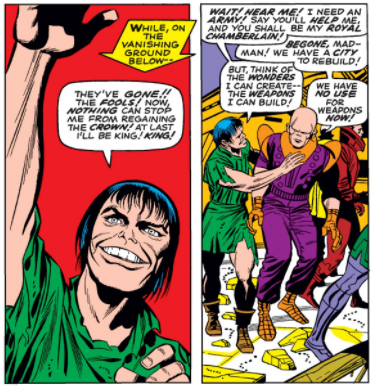 The main story kicks off with Mr Fantastic trying to persuade the entire world to band together to fight "perhaps the most deadly enemy which civilised man has ever faced!" Reluctantly the US agree to hold back so that the Fantastic Four can try to stop Doom, but begin preparing their army just in case they can't. They call this "Operation Build-Up" which is quite a good description of this issue as a whole!
The main story kicks off with Mr Fantastic trying to persuade the entire world to band together to fight "perhaps the most deadly enemy which civilised man has ever faced!" Reluctantly the US agree to hold back so that the Fantastic Four can try to stop Doom, but begin preparing their army just in case they can't. They call this "Operation Build-Up" which is quite a good description of this issue as a whole!
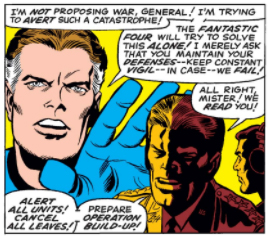 Mr Fantastic remonstrates with himself ("Mr Fantastic! What a monumental mockery that name is!") for having no idea how to defeat doom, so The Thing decides to get him back on track with a good old fashioned punch-up. As usual, this works a treat and Reed Richards heads off to his lab to get some serious thinking done.
Mr Fantastic remonstrates with himself ("Mr Fantastic! What a monumental mockery that name is!") for having no idea how to defeat doom, so The Thing decides to get him back on track with a good old fashioned punch-up. As usual, this works a treat and Reed Richards heads off to his lab to get some serious thinking done.
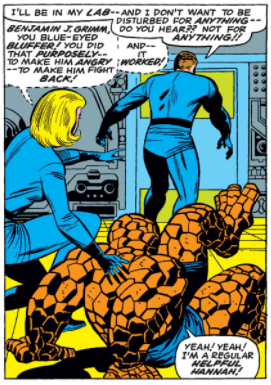 I wonder if Lee and Kirby ever tried this method themselves, when one of them was feeling a bit low? It seems to get used a lot, although it does have its drawbacks. The idea that Reed comes up with to defeat Doom is a gadget that he decides to test by chucking it at his old friend Ben when he's not looking. The device floors the Thing and makes him furious, only for Reed to claim (as is his wont) that this was his plan all along.
I wonder if Lee and Kirby ever tried this method themselves, when one of them was feeling a bit low? It seems to get used a lot, although it does have its drawbacks. The idea that Reed comes up with to defeat Doom is a gadget that he decides to test by chucking it at his old friend Ben when he's not looking. The device floors the Thing and makes him furious, only for Reed to claim (as is his wont) that this was his plan all along.
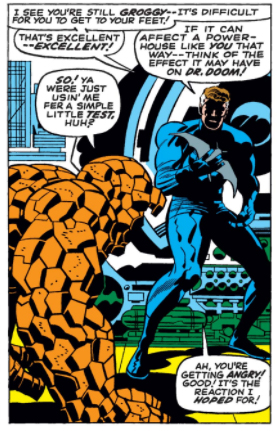 If someone threw an infuriating/knackering device at me without warning I would take a pretty dim view of it, as Ben does here, and would not be inclined to believe that it was the "only" way to test it. It makes me wonder about the collaboration between Lee and Kirby on this section - the images, and indeed the plot, could easily tell a different story, with Reed Richards still angry at his friend for the earlier beating and taking his revenge with the device. Could it be that that was what Kirby originally planned?
If someone threw an infuriating/knackering device at me without warning I would take a pretty dim view of it, as Ben does here, and would not be inclined to believe that it was the "only" way to test it. It makes me wonder about the collaboration between Lee and Kirby on this section - the images, and indeed the plot, could easily tell a different story, with Reed Richards still angry at his friend for the earlier beating and taking his revenge with the device. Could it be that that was what Kirby originally planned?
While all this is going on Doctor Doom is busy enjoying his newfound powers, while also pretending that he is now super-dignified and above such pettiness. When we first see him he's just foiled an attack on Latveria by the Soviet Union, destroying their airforce with a corrosive cloud. For a moment he considers taking further revenge, but then decides not to do so, because such acts of anger are now beneath him.
 Throughout Doom's development his self-delusion has always been a key part of his character, and it's clearly demonstrated here by the way he calmly, regally, decides not to give vent to his anger, preferring instead to pop down to the cellars for a good old gloat (he does love to gloat) over the helpless Silver Surfer, and then giving him a good kicking, in an entirely calm and non-petty way.
Throughout Doom's development his self-delusion has always been a key part of his character, and it's clearly demonstrated here by the way he calmly, regally, decides not to give vent to his anger, preferring instead to pop down to the cellars for a good old gloat (he does love to gloat) over the helpless Silver Surfer, and then giving him a good kicking, in an entirely calm and non-petty way.
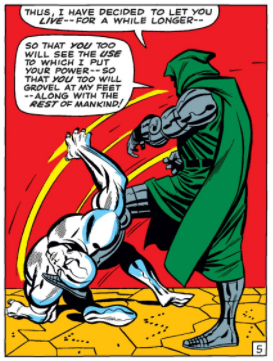 Again, he decides to let the Silver Surfer live so that he can witness Doom's (eventual) takeover of the world, much as he claimed to do with the FF last time. It's almost as if he's been putting off the moment when he has to really use his newfound powers, and it seems like he realises this, saying "I have tarried with you long enough!My greatest task now lies before me!! I must prepare a hopeless humanity for the coming of --"
Again, he decides to let the Silver Surfer live so that he can witness Doom's (eventual) takeover of the world, much as he claimed to do with the FF last time. It's almost as if he's been putting off the moment when he has to really use his newfound powers, and it seems like he realises this, saying "I have tarried with you long enough!My greatest task now lies before me!! I must prepare a hopeless humanity for the coming of --"
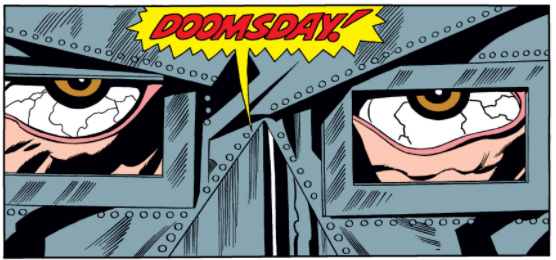 But then what he does is fly off and, for all intents and purposes, play pranks on people. First of all he goes to Central Europe and casts an entire country into total darkness for 24 hours, then buzzes over to the Aegean and makes it snow, before finally turning a gorilla into a monster... for some reason. It's all most perplexing, to the extent that you want him to GET ON WITH IT and start taking over the world.
But then what he does is fly off and, for all intents and purposes, play pranks on people. First of all he goes to Central Europe and casts an entire country into total darkness for 24 hours, then buzzes over to the Aegean and makes it snow, before finally turning a gorilla into a monster... for some reason. It's all most perplexing, to the extent that you want him to GET ON WITH IT and start taking over the world.
This might make for frustrating reading, but it is very much in character for Doom who has, time and time again, put off actually using his power, preferring to just enjoy using it for a bit.
The story ends with Doom deciding that now, at last, there's "no need for further delay" and he can finally start taking over the world.
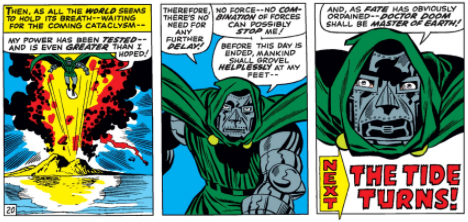 He keeps on saying he's just about to take over the world, but maybe this time he really means it! There's only one way to find out - in our next blog!
He keeps on saying he's just about to take over the world, but maybe this time he really means it! There's only one way to find out - in our next blog!
posted 25/4/2018 by MJ Hibbett
(click here for permanent link)
(0) comments
The Dismal Dregs Of Defeat
After the multiple narrative of last time this issue is all a single story full of plot, playfulness... and prevarication.
When last we saw him Doctor Doom had stolen the Power Cosmic from the Silver Surfer, and was heading out to wreak havoc on the world. However, where other supervillains might get straight to it Doom prefers to savour the moment, making it last as long as possible by zipping around the world causing mischief while his enemies get more and more distressed.
As this story begins Doom is sending terrifying visions of himself to the Fantastic Four via the medium of a lightning storm. He's now all powerful and could destroy them at will, but instead he chooses to have fun by simply giving them the willies. This is how he gets his kicks.
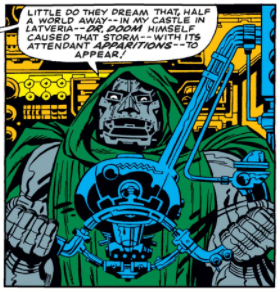 He also likes a good old gloat, so he pops down the corridor to look in on a desolate Silver Surfer, before setting off towards Manhattan. The situation is full of dread for humanity and is expressed in very serious terms... until Stan Lee takes the opportunity to add in a little self-mockery of his own dialogue.
He also likes a good old gloat, so he pops down the corridor to look in on a desolate Silver Surfer, before setting off towards Manhattan. The situation is full of dread for humanity and is expressed in very serious terms... until Stan Lee takes the opportunity to add in a little self-mockery of his own dialogue.
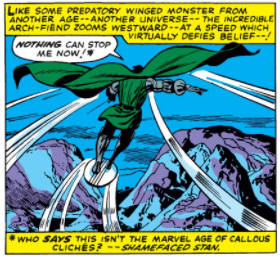 Doom arrives at The Baxter Building to find a spooked Thing (who's been upsetting himself with ghost stories) on his own. Doom attacks, rejoicing in his revenge on the person who humiliated him so much on their last meeting. "Feel the limitless cosmic power in the hand which you once nearly crushed", he says, referring to an injury that clearly bothered him. He mentioned it last time we saw him too!
Doom arrives at The Baxter Building to find a spooked Thing (who's been upsetting himself with ghost stories) on his own. Doom attacks, rejoicing in his revenge on the person who humiliated him so much on their last meeting. "Feel the limitless cosmic power in the hand which you once nearly crushed", he says, referring to an injury that clearly bothered him. He mentioned it last time we saw him too!
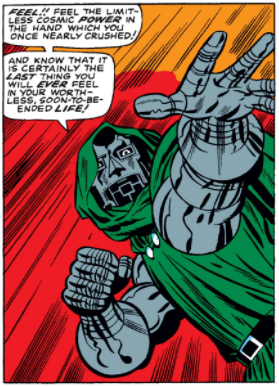 Interestingly Stan Lee does not include a footnote referring us back to the issue Doom's talking about - either he felt readers would all remember, or that the story should not be interrupted, or he forgot!
Interestingly Stan Lee does not include a footnote referring us back to the issue Doom's talking about - either he felt readers would all remember, or that the story should not be interrupted, or he forgot!
After a pitched battle Doom defeats the Thing, but then once again decides to defer his final victory by leaving him standing statue-like in a park. He promises to return to finish Ben off once he's defeated the rest of the Fantastic Four, but one does have to wonder whether Doom is capable of ever learning from his mistakes. Every time he's done this in the past it's ended up being his undoing. It's part of his character - it's right up there with watching telly and jumping out of windows in the Doom Personality Matrix - but it's flipping infuriating!
Doom heads back to the Baxter Building where he finds Reed Richards and sets to giving him a good thrashing with an energy mace, similar to the one the Silver Surfer demonstrated in the previous issue. While this is going on Johnny Storm returns from his travels and discovers Ben trapped in his statue form in the park. When he rushes off to get help he discovers Doom and jumps into action, only to be defeated by a "cosmic drop in temperature" which nullifies his flame completely. Once again Doom refuses to kill him, deeming such things beneath him now.
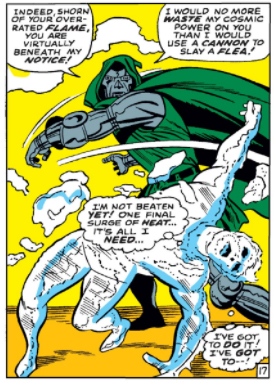 Wyatt Wingfoot uses this month's Handy Reed Richards Gizmo (which Lee describes in some detail, before concluding with "at least, that's how Jack described it to us!") to free The Thing, and the team are united once more. Usually this would be the time for a fightback, but much to everyone's horror Reed concedes that the situation is hopeless, and that Doom has won.
Wyatt Wingfoot uses this month's Handy Reed Richards Gizmo (which Lee describes in some detail, before concluding with "at least, that's how Jack described it to us!") to free The Thing, and the team are united once more. Usually this would be the time for a fightback, but much to everyone's horror Reed concedes that the situation is hopeless, and that Doom has won.
He later says he was playing on Doom's "inconceivable vanity", surrendering in the knowledge that Doom would decide they are all beneath him now and let them live. A lot of the time when Reed Richards says this it's not entirely believable, but here you can sort of see his point. He's basically offering Doom the chance to keep his greatest enemy alive so to bear witness to his continuing victories and, as anyone who knows him would guess, this is something Doom is all too happy to accept.
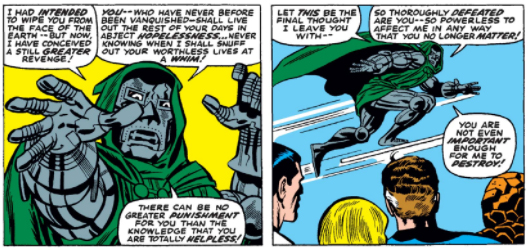 And so the issue ends with Doom flying off, leaving the Fantastic Four still alive but clueless as to what to do next. It's been a fun issue full of fantastic visuals from Kirby as Doom exercises his power, but as a single story it's somewhat unsatisfying. Doom never actually uses his power to the full, and nobody does anything which could stop him. In a modern comic, where creating stories of the correct length for later collection is the norm, one might consider this "padding", but here I suspect Lee & Kirby are enjoying experimenting with the form. They've not long finished their much lauded "Galactus trilogy", which ran over three (obviously) issues, so I wonder if they were trying to repeat the trick here, creating a tale "too big for a single issue" starrring Doom?
And so the issue ends with Doom flying off, leaving the Fantastic Four still alive but clueless as to what to do next. It's been a fun issue full of fantastic visuals from Kirby as Doom exercises his power, but as a single story it's somewhat unsatisfying. Doom never actually uses his power to the full, and nobody does anything which could stop him. In a modern comic, where creating stories of the correct length for later collection is the norm, one might consider this "padding", but here I suspect Lee & Kirby are enjoying experimenting with the form. They've not long finished their much lauded "Galactus trilogy", which ran over three (obviously) issues, so I wonder if they were trying to repeat the trick here, creating a tale "too big for a single issue" starrring Doom?
We'll see how it all works out in the next issue when surely - surely! - Doom will strike for real!
posted 18/4/2018 by MJ Hibbett
(click here for permanent link)
(2) comments
Enter... Dr. Doom (again)
Say what you like about Stan Lee, but when he finds a story title he likes he's not afraid of re-using it - we've already had Doctor Doom Returns twice, and now he's Entering for the second time this year!
That's about the only economising that goes on in this comic, which features at least three separate stories, none of which connect together by the issue's end. It's a style of storytelling that was common in continuing narratives like soap opera, but new to American superhero comics at this time. Where previously an individual issue would contain one or more self-contained stories with little or no sequential continuity between them, here Stan Lee and Jack Kirby are happy to throw us into the middle of one story then cut to another that is almost entirely unrelated. It's no wonder that Sue needs to take a moment, a few pages in, to bemoan how complicated their life has become.
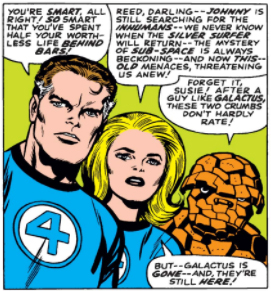 The first story concerns the hunt for The Sandman, a member of the Frightful Four who seems to fight his battles wearing a t-shirt and... nothing else.
The first story concerns the hunt for The Sandman, a member of the Frightful Four who seems to fight his battles wearing a t-shirt and... nothing else.
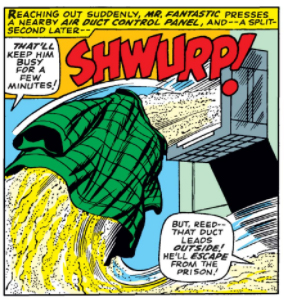 The FF spend most of their time searching the city for him, only for the Sandman to turn up at The Baxter Building and sneak into their secret vault to steal a bunch of weapons. Mr Fantastic estimates that it'll take him at least five minutes to open his own Impregno-Lock and get into the store room but, when he manages to gain entrance "exactly 300 seconds later" he finds that the villain has escaped through the window.
The FF spend most of their time searching the city for him, only for the Sandman to turn up at The Baxter Building and sneak into their secret vault to steal a bunch of weapons. Mr Fantastic estimates that it'll take him at least five minutes to open his own Impregno-Lock and get into the store room but, when he manages to gain entrance "exactly 300 seconds later" he finds that the villain has escaped through the window.
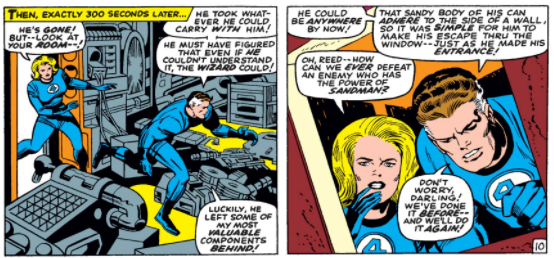 This leads me to ask, once again, whether Reed Richards really is the most intelligent man on earth in the Marvel Universe. Why didn't he just stretch out of an adjacent window and in again that way?
This leads me to ask, once again, whether Reed Richards really is the most intelligent man on earth in the Marvel Universe. Why didn't he just stretch out of an adjacent window and in again that way?
Meanwhile Johnny Storm and Wyatt Wingfoot are on a quest to track down The Inhumans - or at least Johnny's girlfriend, Crystal. They're helped by the Inhhuman dog Lockjaw, who teleports them from place to place, this time dropping them into a whole other dimension full of creatures so enormous and heavy that they've turned their entire world into a car park.
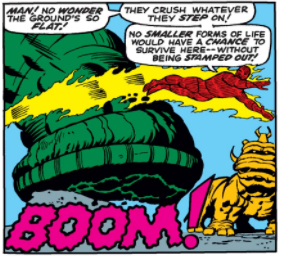 Unbeknownst to Johnny and Wyatt, the Inhumans are actually trapped inside a Negative Barrier in the Himalayas, where the Royal Family are gathered round the bed of their King, Black Bolt. This is a brief interlude, laying the groundwork for future stories, where Maximus The Mad rolls up and tells the assembled superheroes that his brother Black Bolt and Queen Medusa have been lying to them all for years - Black Bolt is perfectly capable of speaking, but he refuses to do so!
Unbeknownst to Johnny and Wyatt, the Inhumans are actually trapped inside a Negative Barrier in the Himalayas, where the Royal Family are gathered round the bed of their King, Black Bolt. This is a brief interlude, laying the groundwork for future stories, where Maximus The Mad rolls up and tells the assembled superheroes that his brother Black Bolt and Queen Medusa have been lying to them all for years - Black Bolt is perfectly capable of speaking, but he refuses to do so!
This would all be more than enough for most comics, but these three plots only take up half of the pages of this issue, with the rest being given over to the first meeting of Doctor Doom and The Silver Surfer!
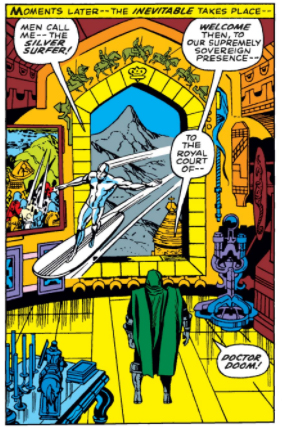 This is yet another example of the way in which Lee and Kirby were developing the shared continuity of the new Marvel Universe. Previously a villain such as Doctor Doom would only be expected to act as a foil for the main characters, while the Silver Surfer was introduced (back in Fantastic Four #48) simply as a supporting character for Galactus, but here these two supposedly secondary characters are able to carry half of the issue by themselves, emerging from the rich world that has been created as leading characters in their own rights.
This is yet another example of the way in which Lee and Kirby were developing the shared continuity of the new Marvel Universe. Previously a villain such as Doctor Doom would only be expected to act as a foil for the main characters, while the Silver Surfer was introduced (back in Fantastic Four #48) simply as a supporting character for Galactus, but here these two supposedly secondary characters are able to carry half of the issue by themselves, emerging from the rich world that has been created as leading characters in their own rights.
Doom has summoned the Surfer to his castle, apparently just to learn more about him. The Surfer is more than happy to explain and demonstrate the capabilities of The Power Cosmic, including generating an incredibly powerful weapon which Doom uses to knock down the room they're standing in.
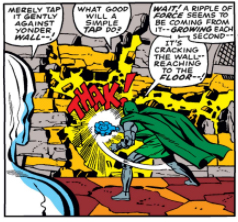 In return Doom takes the Surfer to visit his experimental workshop complex, which manifests as a fantastic splash page of Kirby Tech.
In return Doom takes the Surfer to visit his experimental workshop complex, which manifests as a fantastic splash page of Kirby Tech.
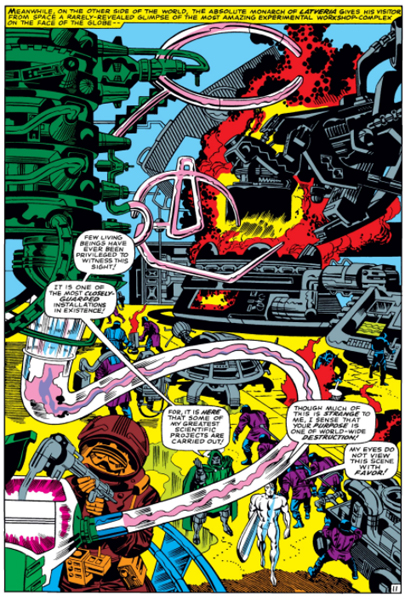 As well as being a wonderful image, this is a fascinating dip into the hyperdiegesis of the Marvel Universe. We know that Doom has all of his technological gizmoes, but we've never yet seen the actual factories where they're built. It makes sense that a national leader like Doom would be able to have weapons plants like this in his country, and indeed employ citizens to work there. We even get a glimpse at Doom's approach to HR when he loses his temper with a clumsy lab worker but then, realising that he's being observed, decides to give him the day off instead of "the ultimate punishment" (which is probably not a written warning).
As well as being a wonderful image, this is a fascinating dip into the hyperdiegesis of the Marvel Universe. We know that Doom has all of his technological gizmoes, but we've never yet seen the actual factories where they're built. It makes sense that a national leader like Doom would be able to have weapons plants like this in his country, and indeed employ citizens to work there. We even get a glimpse at Doom's approach to HR when he loses his temper with a clumsy lab worker but then, realising that he's being observed, decides to give him the day off instead of "the ultimate punishment" (which is probably not a written warning).
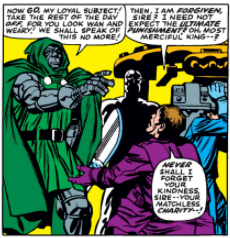 Once again we see here the difference between the image Doom hopes to project, of a benign, caring leader, and the violent despot he really is. This is a constant throughout his fictional life, although his own levels of self-knowledge will vary. Sometimes, as here, it seems that the caring leader is all just an act to impress others, whereas on other occasions he appears to believe that he is genuinely working for the benefit of the Latverian people.
Once again we see here the difference between the image Doom hopes to project, of a benign, caring leader, and the violent despot he really is. This is a constant throughout his fictional life, although his own levels of self-knowledge will vary. Sometimes, as here, it seems that the caring leader is all just an act to impress others, whereas on other occasions he appears to believe that he is genuinely working for the benefit of the Latverian people.
Soon the real reason for his summoning of the Surfer becomes clear, as he pounces on the unsuspecting alien and clamps him into a pair of High Intensity Inductors which transfer the Power Cosmic into Doom himself!
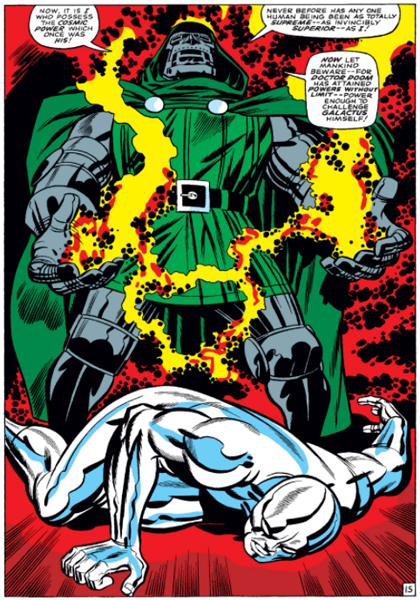 Doom immediately uses his newfound power to hop on the Surfer's board and zoom around the skies of Latveria, blowing up trees and terrifying his subjects. The issue closes with Latverians dreading the prospect of their leader having so much power, and the FF, back in New York, getting an eerie feeling that there are bad times ahead for them.
Doom immediately uses his newfound power to hop on the Surfer's board and zoom around the skies of Latveria, blowing up trees and terrifying his subjects. The issue closes with Latverians dreading the prospect of their leader having so much power, and the FF, back in New York, getting an eerie feeling that there are bad times ahead for them.
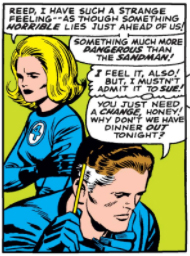 I've got a nasty feeling she might just be right - let's find out, next time!
I've got a nasty feeling she might just be right - let's find out, next time!
posted 11/4/2018 by MJ Hibbett
(click here for permanent link)
(0) comments
Dr. Doom's Day
What a mighty moment in Marvel History this is! Today we're looking at episode 12 of the "Prince Namor the Sub-Mariner" section of "The Marvel Superheroes", a cartoon produced by Gantray Lawrence in 1966. It's the first appearance of Doctor Doom on screen! The first TV appearance of the X-Men too! All as part of a thrilling, half-hour long show that played nightly on TV stations all across America!
There's only one tiny problem with it: it's BLOODY AWFUL.
I hope you'll excuse my distinctly non-academic language here, but the thing is that I had to sit down and watch the whole episode, and there's not really any other way to describe it. Here, see for yourself:
The oddness of these choices does fit in with the general tone of the cartoon, which feels as if it has been chucked together in an insane rush using whatever comes to hand. It's like listening to a four year old making up a story as they go along, but without the charm. One example of this thoughtless chuck-it-together-ness comes right near the start Doom when talks about plotting against his enemies The Allies For Peace (more on them in a moment) as a way to be avenged for "the humiliations of the past." This is a direct lift from his dialogue in Fantastic Four Annual #3, referring to his defeat by The Thing in his previous appearance. In the comic this made sense because we knew what he was referring to, and it involved characters that had appeared before and would appear again soon, but in the cartoon this is Doom's first ever appearance, so we have no idea who he's talking about and, anyway, it will never be mentioned again. So what was the point of including it, other than not wanting to bother writing new dialogue?
One might argue that this is a great example of transmedia storytelling, with the audience already knowing Doom's history from reading the comics. Unfortunately for anybody trying to write a thesis about Doctor Doom as an early transmedia character (i.e. me), that's not what this is. The cartoon makes many references to the orginal comics (which today would be called "Easter Eggs") that only comics readers would understand, while simultaneously changing huge plot points, characters, names an situations so that this story could not possibly exist in the original Marvel universe storyworld.
A good example of this comes when Namor (who narrates the first half of the story without appearing in it) introduces us to Doctor Doom's lair, "The fortified isle of Latveria"
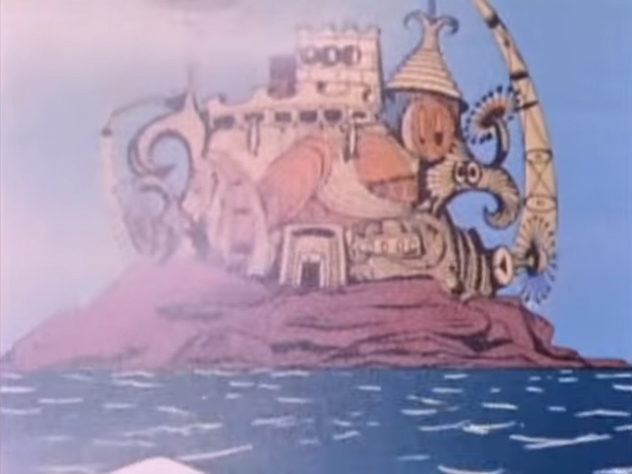 This is not the small Balkan country we've come to know and fear from the comics! I can sort of understand making Doom's lair water-themed to match Namor being an aquatic character, but Namor isn't in this section, and Latveria is never mentioned again, so what on earth was the point?
This is not the small Balkan country we've come to know and fear from the comics! I can sort of understand making Doom's lair water-themed to match Namor being an aquatic character, but Namor isn't in this section, and Latveria is never mentioned again, so what on earth was the point?
And then there's the main protagonists of this section, the X-men - or, rather, The Allies For Peace as they are renamed here. The characters are the same, including Professor X, and they even have an "X" on their uniforms, so why the change?
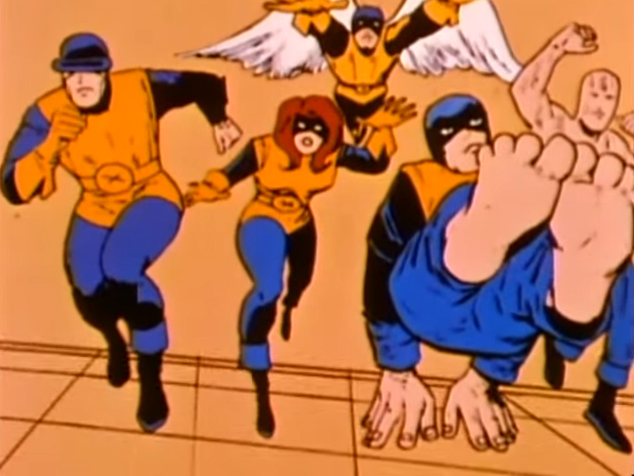 Actually, I say they're the same, but for some reason Hawkeye joins them in the second section of the story. It all reeks of a half-arsed carelessness which pervades all aspects of this production. The "animation" consists of taking photocopies of the original artwork and, for the most part, animating the mouths. The fact that the art has been taken from different comics, different artists and, in the case of the Sub-mariner, different decades, gives the whole thing and queasily inconsistent look, as characters change design from frame to frame. Here's two very different versions of Iceman, for example:
Actually, I say they're the same, but for some reason Hawkeye joins them in the second section of the story. It all reeks of a half-arsed carelessness which pervades all aspects of this production. The "animation" consists of taking photocopies of the original artwork and, for the most part, animating the mouths. The fact that the art has been taken from different comics, different artists and, in the case of the Sub-mariner, different decades, gives the whole thing and queasily inconsistent look, as characters change design from frame to frame. Here's two very different versions of Iceman, for example:
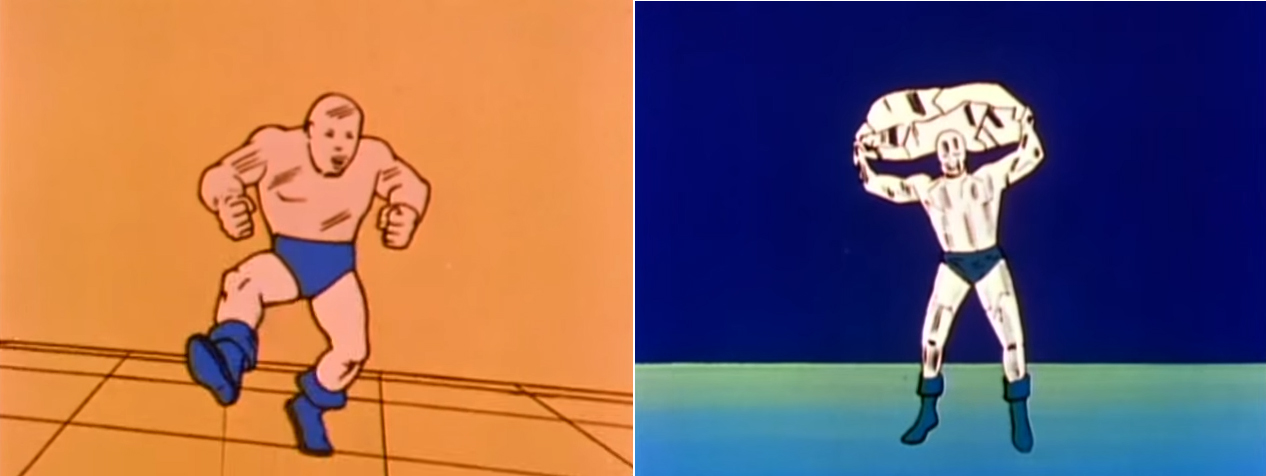 The storytelling is similarly hopeless. Although the episode is called "Dr. Doom's Day" the words "Doctor Doom" are not even spoken until almost eight minutes into the story, when Doom is finally named. Anybody new to the cartoon would have no idea who he was, although when he finally say who he is he does very helpfully point at himself to make it absolutely clear.
The storytelling is similarly hopeless. Although the episode is called "Dr. Doom's Day" the words "Doctor Doom" are not even spoken until almost eight minutes into the story, when Doom is finally named. Anybody new to the cartoon would have no idea who he was, although when he finally say who he is he does very helpfully point at himself to make it absolutely clear.
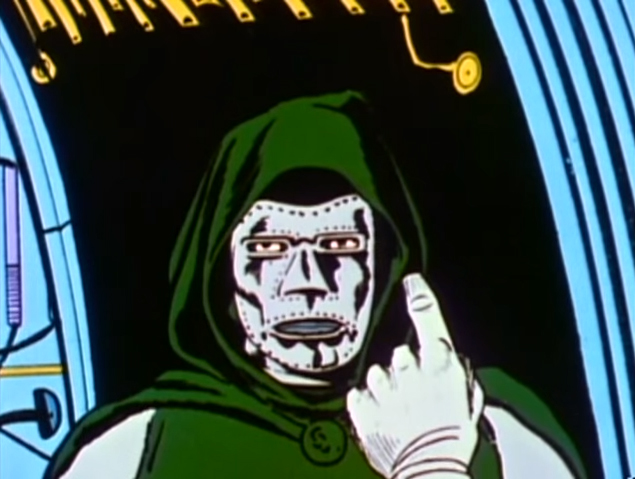 This introduction takes place in the second section of the show, where Namor finally appears and heads into New York as the adaptation switches to Fantastic Four #6. Again, The Allies for Peace stand in for the Fantastic Four, although the animators did not manage to remove all references to the FF, notably when their logo appears on the building scanners.
This introduction takes place in the second section of the show, where Namor finally appears and heads into New York as the adaptation switches to Fantastic Four #6. Again, The Allies for Peace stand in for the Fantastic Four, although the animators did not manage to remove all references to the FF, notably when their logo appears on the building scanners.
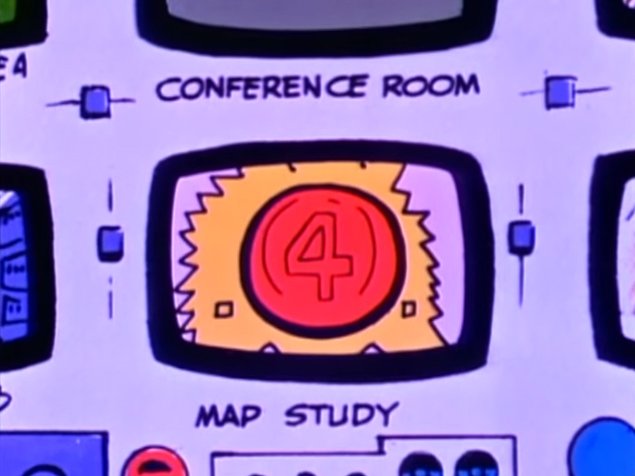 At the point Namor takes over from the Allies (or "The Defenders" as the narrator inexplicably calls them at one point) as the main hero, while Doom becomes more straightforwardly villainous, spouting dialogue that he would never say in the comic, even stooping to puns when he puts the Baxter Building on a collision course with the sun "which I am certain will receive you warmly." This is not the Doom we know!
At the point Namor takes over from the Allies (or "The Defenders" as the narrator inexplicably calls them at one point) as the main hero, while Doom becomes more straightforwardly villainous, spouting dialogue that he would never say in the comic, even stooping to puns when he puts the Baxter Building on a collision course with the sun "which I am certain will receive you warmly." This is not the Doom we know!
The episode continues to get (even) worse, including an section where the narrator tells us that, millions of miles away, a meteor storm has erupted. "That meteor storm is what I'm counting on!" says Namor immediately afterwards, making me think of the bits in Dangermouse when they'd talk back to the narrator... except much less funny.
The all round can't-be-arseness of the episode reaches a climax towards the end, where it's clear that the foreground for Doctor Doom's slipped during animation, and nobody could be bothered to fix it!
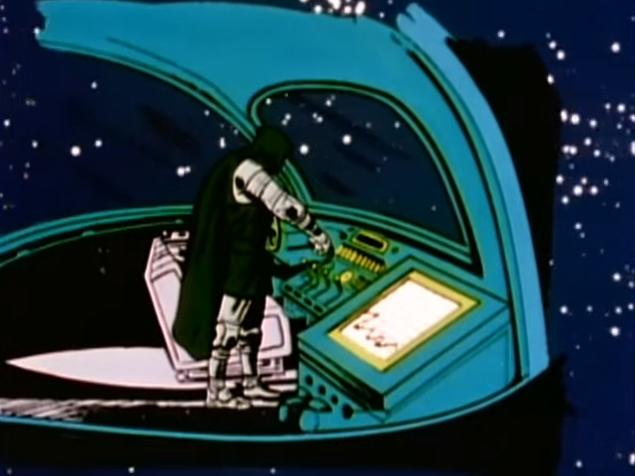 It finally ends with Doctor Doom chucking himself out into space, which is at least traditional. All in all, it's a dreadful business which makes you very glad that at least Stan Lee has lived long enough to see his creations done properly.
It finally ends with Doctor Doom chucking himself out into space, which is at least traditional. All in all, it's a dreadful business which makes you very glad that at least Stan Lee has lived long enough to see his creations done properly.
One extra, intriguing, aspect to this series of cartoons is the fact that WNAC-TV in Boston made a series of short live films introducing the cartoons, written by none other than Jerry Siegel and featuring Captain America, Hulk, Bucky and Doctor Doom! The only film that survives is the short clip below, taken by a fan on a super-8 character, but even this low quality recording shows more of an understanding of Marvel's appeal than this terrible cartoon:
posted 6/4/2018 by MJ Hibbett
(click here for permanent link)
(0) comments
Enter Doctor Doom
This is only Doctor Doom's second proper appearance outside of The Fantastic Four or Strange Tales (his first being in Amazing Spider-Man #5) and, as we'll see, he's not quite his own man yet. The Fantastic Four get mentioned and even appear (in a marvellously honestly heralded "brief appearance", mentioned on the cover), as if he's not quite ready to strike out completely on his own just yet.
It's clear that he's popular though - his image is much bigger than that of the other characters on the cover, and it's assumed that readers will know who he is. It's possible that they may even have guessed who was lurking menacingly at the end of Avengers #24.
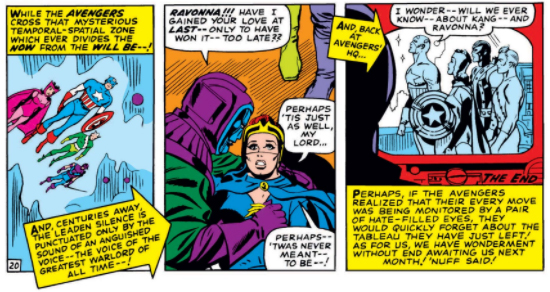 This story continues immediately after the last one, with a neat pull-back to reveal who was watching.
This story continues immediately after the last one, with a neat pull-back to reveal who was watching.
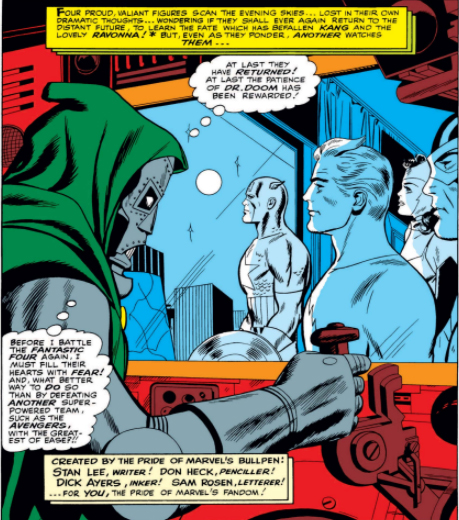 To be honest, anyone who knows Doctor Doom should have guessed it was him. Who else LOVES watching other people on telly this much?
To be honest, anyone who knows Doctor Doom should have guessed it was him. Who else LOVES watching other people on telly this much?
I said that Doom himself needs no introduction, as a character, but he does supply a small recap to bring us up to date with his relationship with Kang, the villain of the past few issues. As with previous recaps, this features a faithful redrawing of selected panels from the stories he's referring to, this time taken from Fantastic Four Annual #2.
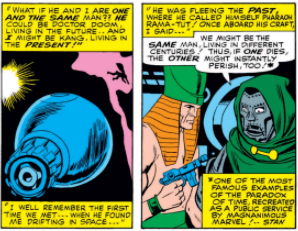
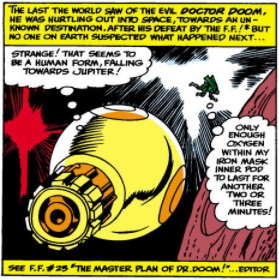 This does, unfortunately, mean we get a retelling of the extremely confusing/nonsensical version of a time paradox, but luckily for us Doom does not dwell on this, preferring to return to spying on The Avengers.
This does, unfortunately, mean we get a retelling of the extremely confusing/nonsensical version of a time paradox, but luckily for us Doom does not dwell on this, preferring to return to spying on The Avengers.
Doom's plan is to annihilate The Avengers purely to put the frighteners on The Fantastic Four, but as he watches them go about their daily business he must surely wander whether he's still snooping on the FF, just wearing different costumes. There's four characters - three men and a woman - who don't really get on with each other, a brother and sister relationship, a hint of a love triangle, and a lot of bickering, especially between the leader and the other non-sibling.
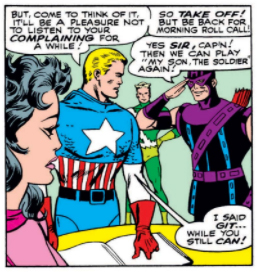 In the Matt Yockey's (excellent) book Make Ours Marvel, Mark Minett and Bradley Schauer talk about the way that this line-up of the Avengers - "Cap's Kooky Quartet" of Captain America, Hawkeye, The Scarlet Witch and Quicksilver - came about. They theorise that the original "all star" line-up (including Iron Man, Hulk and Thor, all of whom had their own series) placed restrictions on the extent to which the creative team could explore characterisation. Any big changes for Tony Stark, for instance, would happen in his own series, not in the team book. Thus, by revamping the team with (mostly) minor characters, Stan Lee and his collaborators could delve into the kind of character interplay that had made the Fantastic Four such a success. The fact that they changed the line-up to pretty much copy the FF does suggest that this theory is correct!
In the Matt Yockey's (excellent) book Make Ours Marvel, Mark Minett and Bradley Schauer talk about the way that this line-up of the Avengers - "Cap's Kooky Quartet" of Captain America, Hawkeye, The Scarlet Witch and Quicksilver - came about. They theorise that the original "all star" line-up (including Iron Man, Hulk and Thor, all of whom had their own series) placed restrictions on the extent to which the creative team could explore characterisation. Any big changes for Tony Stark, for instance, would happen in his own series, not in the team book. Thus, by revamping the team with (mostly) minor characters, Stan Lee and his collaborators could delve into the kind of character interplay that had made the Fantastic Four such a success. The fact that they changed the line-up to pretty much copy the FF does suggest that this theory is correct!
Back in this issue, the Scarlet Witch, gets a letter claiming to be from a long lost Auntie in Latveria. She rushes off to tell her brother Quicksilver, who, like all young men in the Marvel Universe, is watching telly. He's too engrossed to listen to her, so she uses her mighty Hex Power to turn it off.
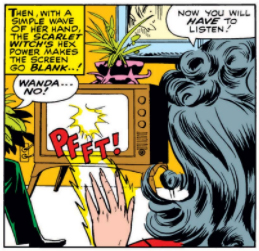 Throughout this issue Wanda's superpowers manifest almost exclusively as a supernatural remote control. Maybe The Human Remote Control should have been her superhero name?
Throughout this issue Wanda's superpowers manifest almost exclusively as a supernatural remote control. Maybe The Human Remote Control should have been her superhero name?
Doom is still watching them, but once he sees that his trap (the letter was from him, pretending to be an Auntie! What a rotter!) has worked he goes off for a walk around Latveria, giving us our first extended visit to the "tiny Balkan kingdom". Previously we've only seen short glimpses, even in Doom's origin story, but here it becomes the main setting for the entire issue.
When Doom first steps outside we see him walking through a crowd in a panel that echoes Jack Kirby's street scene from Fantastic Four Annual #2.
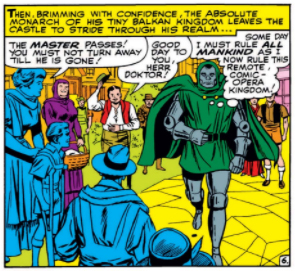
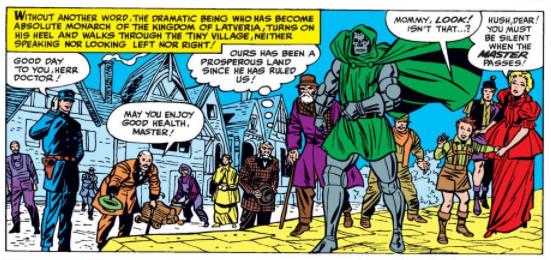 Kirby's panel will be echoed again many years later in John Byrne's classic "This Land Is Mine", although Byrne will use the same camera angle as Don Heck does here:
Kirby's panel will be echoed again many years later in John Byrne's classic "This Land Is Mine", although Byrne will use the same camera angle as Don Heck does here:
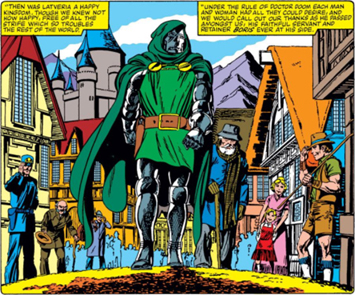 It's disconcerting to see Doom referring to his nation, even internally, as a "comic opera kingdom" - I'm sure he wouldn't appreciate anybody else calling it that - but it does mark the start of Doom's transformation into a slightly less sympathetic character. The more we see of his kingdom, and the way he rules over his citizens, the less noble he appears.
It's disconcerting to see Doom referring to his nation, even internally, as a "comic opera kingdom" - I'm sure he wouldn't appreciate anybody else calling it that - but it does mark the start of Doom's transformation into a slightly less sympathetic character. The more we see of his kingdom, and the way he rules over his citizens, the less noble he appears.
The Avengers arrive by train and are almost instantly arrested by the Latverian police, who throw them into prison. Exactly thirty minutes later (I'm not sure why it's important that it's exactly half an hour, but this will crop up again later) Cap realises where it is they've ended up.
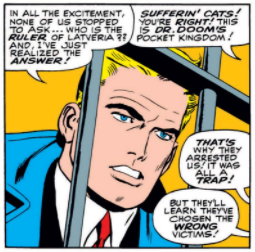 Oh THAT Latveria! Of course! Once that's all clear they immediately escape which, Doctor Doom claims shortly afterwards, is exactly what he expected them to do. So why does he have them arrested in the first place? Maybe the fact that I have to ask is why I've never made it as a supervillain, or maybe this is another example of Doom's nobility losing its shine, and him becoming more like the self-deluding despot that we'll see more of in the 1970s.
Oh THAT Latveria! Of course! Once that's all clear they immediately escape which, Doctor Doom claims shortly afterwards, is exactly what he expected them to do. So why does he have them arrested in the first place? Maybe the fact that I have to ask is why I've never made it as a supervillain, or maybe this is another example of Doom's nobility losing its shine, and him becoming more like the self-deluding despot that we'll see more of in the 1970s.
Doom seals off the kingdom with a "plastithene" dome which he'd built to protect the country from nuclear attack and the Latverians take to the streets to capture the Avengers. Here Latveria becomes a symbol for Communist Eastern Europe, with the American superteam unable to understand why the people remain loyal to a dictator Doom - the only possible explanation is propaganda!
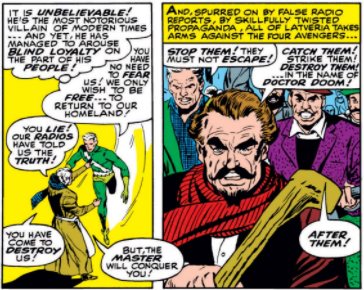 To be fair to Doom, he has built a gigantic dome to protect his subjects from nuclear attack, and they're always talking about how much better he is than the aristocracy he overthrew. The fact that Doom has an entire nation of loyal subjects who will do his bidding for him is also an interesting variation on superpowers. He has the strength of thousands, just in thousands of different bodies!
To be fair to Doom, he has built a gigantic dome to protect his subjects from nuclear attack, and they're always talking about how much better he is than the aristocracy he overthrew. The fact that Doom has an entire nation of loyal subjects who will do his bidding for him is also an interesting variation on superpowers. He has the strength of thousands, just in thousands of different bodies!
The Avengers head to the castle and fight Doom one by one, with him easily beating them. They only get away when one of Hawkeye's arrows make a mess of his armour, forcing him to go and get changed. Exactly thirty minutes later (I said it'd be back!) he's all cleaned up and heading back to the fight when he bumps into a delegation of Latverians who ask him to take down the dome so a local lad can pop to the next country to see a physician.
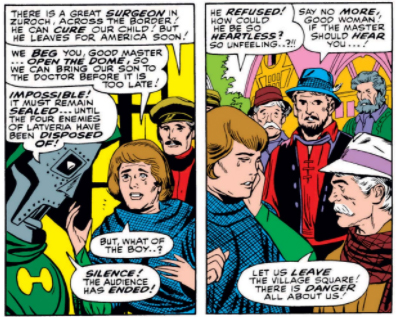 Doom's refusal is a blow to the people, who are confused to find him so uncaring. There's no time to examine this, however, as the story hops back to the USA for the "brief guest appearance of the Fantastic Four" that we were promised. It seems to me that this is Stan Lee trying to pre-empt the next batch of letters from readers who would have asked why the FF didn't get involved, as this one page interlude explains that they can't go over to help the Avengers: Washington won't let them.
Doom's refusal is a blow to the people, who are confused to find him so uncaring. There's no time to examine this, however, as the story hops back to the USA for the "brief guest appearance of the Fantastic Four" that we were promised. It seems to me that this is Stan Lee trying to pre-empt the next batch of letters from readers who would have asked why the FF didn't get involved, as this one page interlude explains that they can't go over to help the Avengers: Washington won't let them.
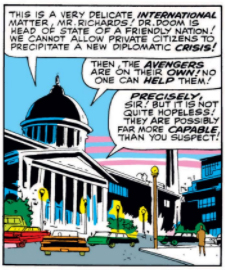 I'm not sure I'd describe Doom and Latveria as "friendly" - hasn't he tried to destroy and/or take over the USA on a couple of occasions already? Maybe that's the reason I'm also not a leading diplomat, but it's another example of the way Doom has powers beyond that of a conventional supervillain. Indeed, he has the kind of superpowers that actually do exist in the real world - fanatical loyalty and diplomatic immunity.
I'm not sure I'd describe Doom and Latveria as "friendly" - hasn't he tried to destroy and/or take over the USA on a couple of occasions already? Maybe that's the reason I'm also not a leading diplomat, but it's another example of the way Doom has powers beyond that of a conventional supervillain. Indeed, he has the kind of superpowers that actually do exist in the real world - fanatical loyalty and diplomatic immunity.
While all this is going on the Avengers find out about the plight of the young boy, and realise they've got to get a shift on. This introduces some much needed Jeopardy to the story - the team now has a deadline for their escape, rather than being able to take their time or wait for help. If they don't get out and/or destroy the dome, the boy will die!
They return to the castle, where Doom fights them to a standstill once again. He uses a lot of scientific gadgetry and devices to fight the heroes, though it's noticeable that his magical powers have pretty much been forgotten. The only magic used comes from Wanda, who uses her Human Remote Control abilities to switch off Doom's disintegrator gun.
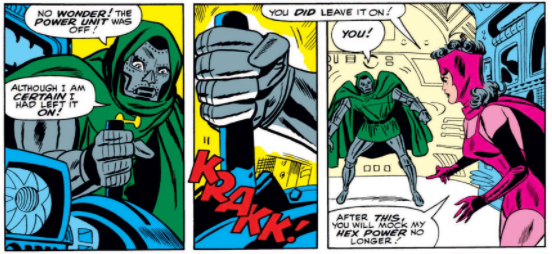 This time the Avengers fight as a team, rather than individually, and although they still don't manage to properly beat Doom, they do at least escape (by making him sneeze too much to concentrate on them), closing the dome in the process so that the boy can get to hospital.
This time the Avengers fight as a team, rather than individually, and although they still don't manage to properly beat Doom, they do at least escape (by making him sneeze too much to concentrate on them), closing the dome in the process so that the boy can get to hospital.
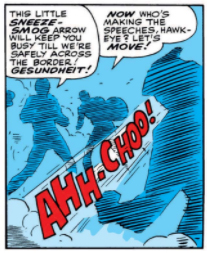 The issue ends with a final panel reminiscent of several Fantastic Four stories, with the four team members looking back on their adventure and offering their own different interpretations of what's happened, ranging from Quicksilver's "Another fruitless quest! Another disappointment!" to the Scarlet Witch's "Even tho it was all in vain, we fought like a team... and we won!" These thoughts reinforce the overall pointlessness of their actions - they were fooled into going to Latveria, and when they were there they risked the life of a young boy and only just managed to escape with their lives. In a sense they were the villains of the story, entering Doom's domain, fighting him and, like Doom himself has done at the end of so many other adventures, running away, leaving their enemy behind.
The issue ends with a final panel reminiscent of several Fantastic Four stories, with the four team members looking back on their adventure and offering their own different interpretations of what's happened, ranging from Quicksilver's "Another fruitless quest! Another disappointment!" to the Scarlet Witch's "Even tho it was all in vain, we fought like a team... and we won!" These thoughts reinforce the overall pointlessness of their actions - they were fooled into going to Latveria, and when they were there they risked the life of a young boy and only just managed to escape with their lives. In a sense they were the villains of the story, entering Doom's domain, fighting him and, like Doom himself has done at the end of so many other adventures, running away, leaving their enemy behind.
In many ways this story sets the tone for a lot of what's to come, especially Doom's solo adventures in "Astonishing Tales" and "Supervillain Team-Up", but that's still a few years in the future. What comes next for us on this blog is the thrilling debut of Doctor Doom on television - gird yourselves for this one, it is going to be AWFUL!
posted 4/4/2018 by MJ Hibbett
(click here for permanent link)
(0) comments
This Time You Can't Blame Stan
When I first sat down to read this issue I was a little puzzled, as there was absolutely no mention of Doctor Doom in it whatsoever. There's plenty of other stuff, not least the highly enjoyable introduction of Hercules, but no Doom.
It's not the first time this has happened - The Corpus Of Doom (which is what I should have called my big list of comics from the start) is collated from several different databases, all of which have had lots of different people adding information to them at different times in different ways, which means that sometimes the data entry criteria gets a bit muddled. For instance, in Incredible Hulk #2 there was an advert for Fantastic Four #5 (discussed here) featuring Doctor Doom, so somebody somewhere thought that that should be included as part of the comic, whereas normally only the actually story contents "count" towards appearances.
I thought that something similar might be going on here, and after a bit of googling I discovered that it was. In several Marvel comics published this month there appeared an advert for an Incredible Hulk Sweat Shirt, starring Doctor Doom:
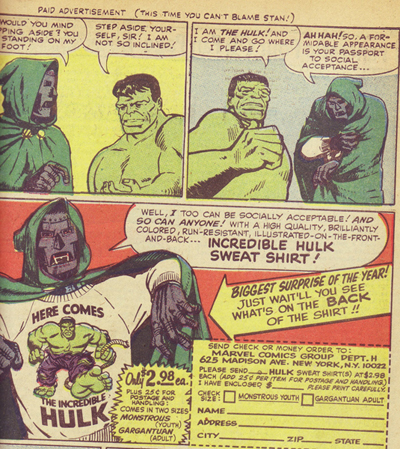 This image, and a lot more information about it, can be found in an excellent blog by Nick Caputo at Marvel Mysteries and Comics Minutiae. According to him this advert was written and drawn by Marie Severin, which makes her the first person to ever write Doctor Doom apart from Stan Lee!
This image, and a lot more information about it, can be found in an excellent blog by Nick Caputo at Marvel Mysteries and Comics Minutiae. According to him this advert was written and drawn by Marie Severin, which makes her the first person to ever write Doctor Doom apart from Stan Lee!
There's something rather fitting about Doom's first appearance without Stan Lee's stewardship being for an advert, or at least there is if you happen to be writing a thesis about him as an early transmedia character! It would be several more years before other people began to write Doom in the main Marvel Universe continuity, but from this point onwards he will start to appear regularly in all sorts of other media, out of Lee's control. Indeed, around this time 'The Marvel Super Heroes' cartoon would have been in development, at which point Doom (and much of the rest of Marvel comics) would truly begin to become transmedia characters. And it all began with a sweatshirt!
posted 2/4/2018 by MJ Hibbett
(click here for permanent link)
(0) comments